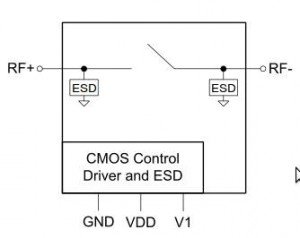SAN DIEGO–(BUSINESS WIRE)–Peregrine Semiconductor Corporation (NASDAQ: PSMI), a fabless provider of high-performance radio frequency integrated circuits (RFICs), today announced a single-pole, single throw (SPST) antenna tuning switch for LTE-Advanced (LTE-A) smartphones. This latest addition to Peregrine’s series of tuning devices leverages Peregrine’s UltraCMOS® process using the HaRP™ and DuNE™ enhancements to deliver an ideal combination of performance and integration to 4G wireless platforms. In a related announcement today, the PE613010 antenna tuning switch has already been chosen by Pantech to drive performance in its new Vega LTE-A handset.
Peregrine’s tuning products are designed to help 4G handset manufacturers implement tunable antennas, the benefits of which include faster data throughput, smaller size and enhanced overall consumer experience. Based on Peregrine’s UltraCMOS technology, the PE613010 antenna switch delivers the industry’s lowest resistance-on (Ron) of 1.2 Ohms from 700-2700MHz. This maximizes radiated performance of the antenna in support of higher data throughput, increased battery life and longer range for fewer dropped calls. Manufacturers can achieve this performance while also minimizing size in support of thinner form factor phones. The new PE613010 antenna tuning switch is supplied in a miniature 2 x 2 x 0.55 mm package that requires zero external components.
Peregrine Semiconductor has announced a single-pole, single throw antenna tuning switch for LTE-Advanced smartphones.
Called PE613010, it has already been designed in to the Vega LTE-A phone, available for use on SK Telecom’s network in Korea, by Pantech.
The switch has an on-resistance of 1.2ohms from 700 to 2,700MHz, claimed to be industry’s lowest, and comes in a 2 x 2 x 0.55mm package that requires no external components.
“With single-pin low voltage CMOS control, all decoding and biasing is integrated on-chip and no external bypassing or filtering components are required,” said Peregrine.
Electrostatic discharge tolerance is 2kV (human body model) on all pins.
Both switch and an evaluation kit to go with it are available now.
The fabless firm used silicon-on-insulator for its switches.
In this case, VDD operating range is 2.3-4.8V, Coff is 0.4pF, and the packackage is a 10 pin QFN.
No data sheet appears to be available yet.
– See more at: http://www.electronicsweekly.com/news/components/analogue-and-discretes/peregrine-aims-at-lte-a-handsets-with-antenna-tuning-switch-2013-08/#sthash.7uDUOYCe.dpuf

